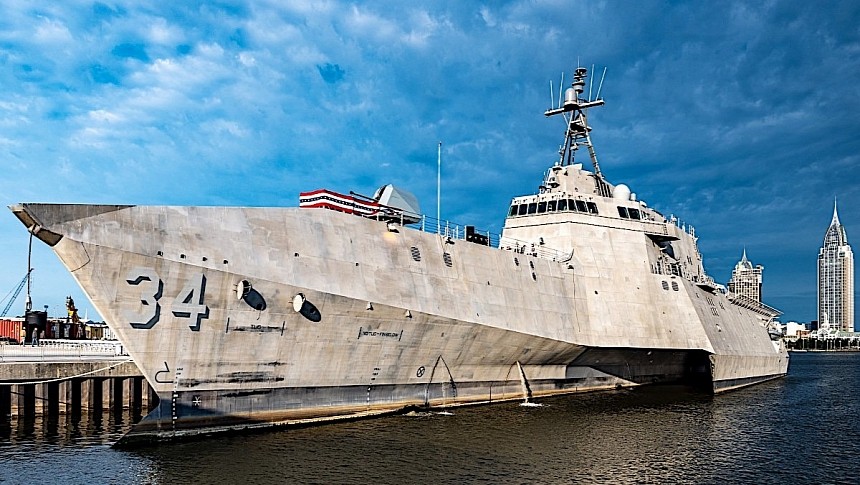Depending on how and what they're used for, the U.S. Navy’s most important assets, its ships, fall into different categories. One of the most visible, even from the shores of both America and other nations, are the so-called Littoral Combat Ships (LCS).
We're generally speaking about ships smaller than we're used to, deployed for, as the name says, military operations near shores. The American Navy has two classes of these ships in its arsenal, the Freedom and Independence – that's right, just like the spaceships Bruce Willis & co used to travel to a killer asteroid in Armageddon.
The former will eventually grow to a fleet of 16 ships (probably as soon as this year), while the latter will have 19 of them. It's the Independence class that's closest to completion, with just two of them left to be delivered now that the 17th in the fleet, USS Augusta (LCS 34), just did that.
Just like the others in its family, the USS Augusta is a high-speed, shallow draft weapons platform. It comes with an aluminum trimaran hull, has a displacement of 2,307 metric tons, and can carry a crew of up to 75 people. It is powered by two gas turbines, two diesel engines, and four diesel generators, and can travel at sea for distances of 4,900 miles (7,900 km) and at speeds of up to 46 mph (74 kph).
The ship is armed with a 57 mm gun, several .50 cals, and a number of missile launchers. Two helicopters can be carried on its deck, but also the new MQ-8 Fire Scout drone helicopter.
The Augusta was christened in December last year, and this week its maker, Austal, announced its delivery to the Navy. Its home port is that of Naval Base San Diego, from where it will depart on missions of surface, mine, and anti-submarine warfare. The ship is presently being fitted with all the required hardware for these missions.
The Navy started taking delivery of Independence LCS ships back in 2006, when the USS Independence entered service. Since then, sixteen others have done that, and two more are left, the USS Kingsville (LCS 36) and USS Pierre (LCS 38).
The same company that makes these ships, Austal, also delivered to the U.S. Navy earlier this year the USNS Apalachicola. That would be a platform meant for V-22 Osprey operations, and at the same time the American Navy's “largest ship with the capability to operate as an unmanned surface vessel (USV)."
What that means is the thing can stay at sea completely uncrewed for up to a month, thanks to the technologies that went into it: a perception and situation awareness suite, an autonomy controller, and an autonomous machinery control system.
The former will eventually grow to a fleet of 16 ships (probably as soon as this year), while the latter will have 19 of them. It's the Independence class that's closest to completion, with just two of them left to be delivered now that the 17th in the fleet, USS Augusta (LCS 34), just did that.
Just like the others in its family, the USS Augusta is a high-speed, shallow draft weapons platform. It comes with an aluminum trimaran hull, has a displacement of 2,307 metric tons, and can carry a crew of up to 75 people. It is powered by two gas turbines, two diesel engines, and four diesel generators, and can travel at sea for distances of 4,900 miles (7,900 km) and at speeds of up to 46 mph (74 kph).
The ship is armed with a 57 mm gun, several .50 cals, and a number of missile launchers. Two helicopters can be carried on its deck, but also the new MQ-8 Fire Scout drone helicopter.
The Augusta was christened in December last year, and this week its maker, Austal, announced its delivery to the Navy. Its home port is that of Naval Base San Diego, from where it will depart on missions of surface, mine, and anti-submarine warfare. The ship is presently being fitted with all the required hardware for these missions.
The Navy started taking delivery of Independence LCS ships back in 2006, when the USS Independence entered service. Since then, sixteen others have done that, and two more are left, the USS Kingsville (LCS 36) and USS Pierre (LCS 38).
The same company that makes these ships, Austal, also delivered to the U.S. Navy earlier this year the USNS Apalachicola. That would be a platform meant for V-22 Osprey operations, and at the same time the American Navy's “largest ship with the capability to operate as an unmanned surface vessel (USV)."
What that means is the thing can stay at sea completely uncrewed for up to a month, thanks to the technologies that went into it: a perception and situation awareness suite, an autonomy controller, and an autonomous machinery control system.











